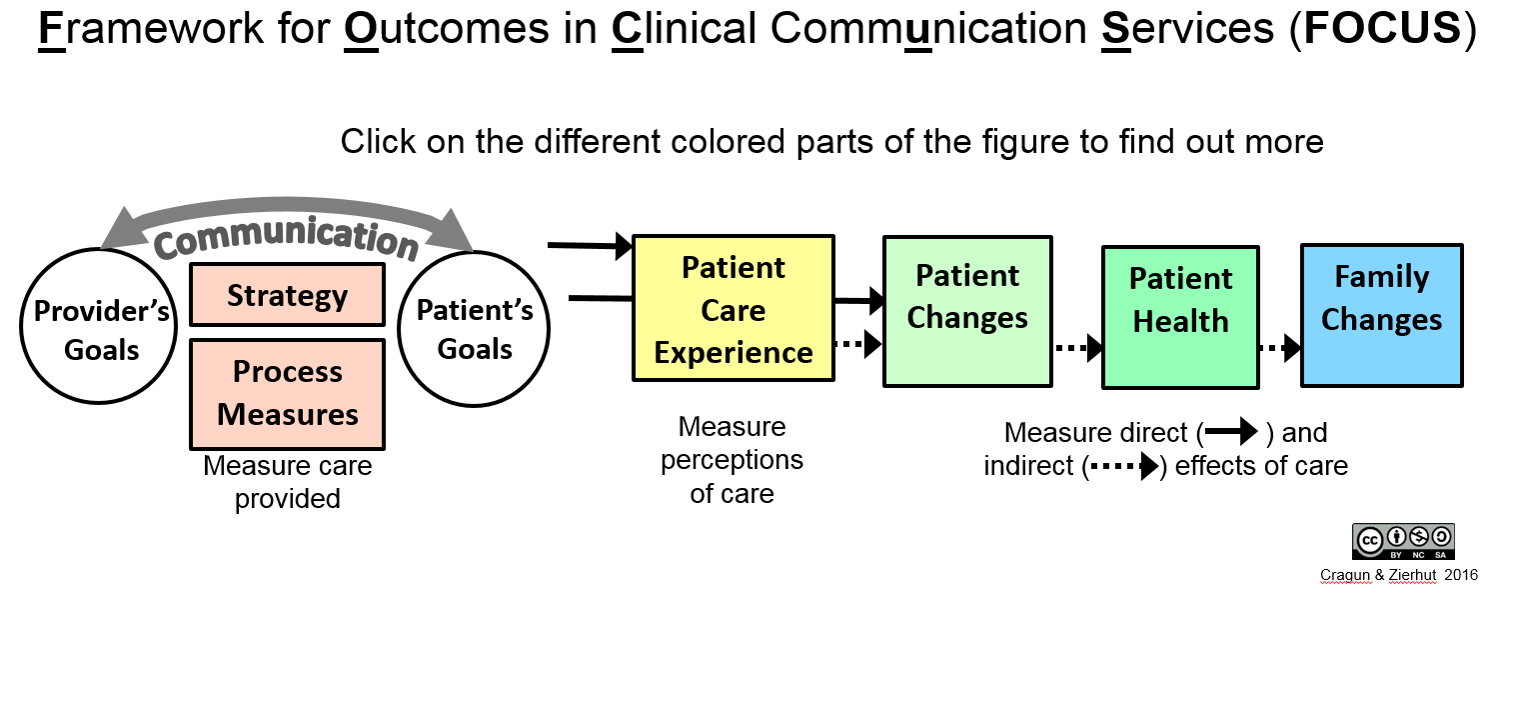FOCUS organizes and defines a broad array of communication processes as well as patient or family changes and "outcomes" that may help you:
• Develop ideas about how to evaluate clinical communication services (including patient education, genetic counseling, and care coordination)
• Select which goals and “outcomes” are of most interest to you
• Design a communication strategy by combining communication processes that may help you achieve your goal
FOCUS consists of six domains:
1. strategy
2. communication process measures
3. patient care experiences
4. patient changes
5. patient health
6. family changes

Strategy
Communication processes or skills that are combined to achieve patient and provider goals and positively influence patient experiences, changes, or health.
Examples: mutual agenda setting, educating, responding to emotions, care coordination.
To view a more comprehensive table of strategies please click here.
Communication Process Measures
These measure communication that occurs during a clinical encounter.
Example Categories:
Checklists, chart reviews, or third-party observation to document: use of communication strategies, provider adherence to professional guidelines, care coordination, patients’ level of involvement.
Example Measures:
The proportion of individuals with a strong family history of breast and ovarian cancer who receive an “uninformative negative” genetic test result and are told they still require high-risk cancer screening that differs from general population screening.
To view a comprehensive table of categories and additional examples in this domain please click here.
Patient Care Experience
Feedback from patients and their family members or caregivers about their experiences related to the delivery of patient care.
Example Categories:
meeting patient needs, perceptions of patient/provider relationship, perceptions of communication, and perceptions of information received.
Example Measures:
The percentage of a particular group of patients who reported their health provider communicated well.
To view a comprehensive table of categories and additional examples in this domain please click here.
Patient Changes
Cognitive, emotional or behavioral changes that occur during or after the visit with the healthcare provider. [These occur as a direct or indirect result of care received and are hypothesized or shown to influence patient health outcomes.]
Example Categories:
knowledge, attitudes/beliefs, empowerment, adherence to health recommendations, accessed appropriate resources or health services
Example Measures:
The percentage of patients who report feeling highly empowered to cope with emotions related to a particular diagnosis.
To view a comprehensive table of categories and additional examples in this domain please click here.
Patient Health
Changes in physical, mental, or social health.
Example Categories:
Survival, symptoms, cognitive functioning, physical functioning, social functioning, mental health, well-being.
Example Measures:
The proportion of patients with a reduction in symptoms associated with a particular condition.
To view a comprehensive table of categories and additional examples in this domain please click here.
Family Changes
Factors that change among the patient’s family as an indirect result of health services provided to a patient.
Example Categories:
Family communication, family functioning, family member access to appropriate care, caregiver burden.
Example Measures:
The proportion of family members at risk for hereditary cancer who access appropriate care (or proportion who do not access care that is unnecessary).
To view a comprehensive table of categories and additional examples in this domain please click here.